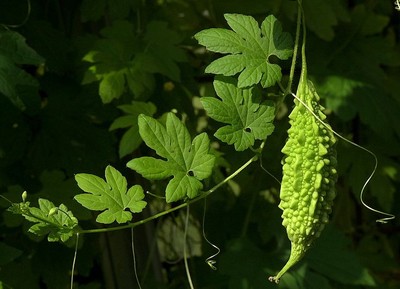
Common Name: Karela,
English Name: Carilla fruit, Bitter Gourd, Bitter Melon
Botanical Name: Momordica charantia Linn.
Family: Cucurbitaceae
Description: The plants are monoecious. The flowers are up to 1 1/4 inches (3 cm) across and have 5 ruffled, egg-shaped petals. The female flowers are followed by warty, egg-shaped to oblong, green ripening to yellow and then orange fruit with a tapering tip. When fully ripe, the orange fruits split open into 3 curling segments to reveal black seeds enclosed in soft, bright red pulp.
Chemical Constituents: Plant contains alkaloids, glycoside, peptides, acids, cucurbitins, charantin, cucurbitacins, momordine, momorcharins, and proteins. It is thought that the primary constituents responsible for the hypoglycemic properties are charantin, insulin-like peptide [plant-(p)-insulin], cucurbutanoids, momordicin, and oleanolic acids.
Properties: It contains phyto-nutrient, polypeptide-P, a plant insulin known to lower blood sugar levels. In addition, it composes hypoglycemic agent called charantin. Charantin increases glucose uptake and glycogen synthesis inside the cells of liver, muscle and adipose tissue. Together, these compounds have been thought to be responsible for reduction of blood sugar levels in the treatment of type-2 diabetes. Further, it is an excellent source of health benefiting flavonoids such as ß-carotene, α-carotene, lutein, and zea-xanthin. Bitter melon stimulates easy digestion and peristalsis of food through the bowel until it is excreted from the body. Thus, it helps in relieving indigestion and constipation problems.
Used in the following MATXIN product: